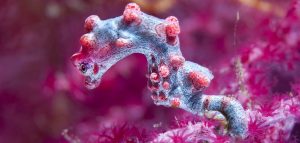Have you ever meet a seahorse? This wonderful creature might only be seen in your childhood illustration storybooks, along with mermaids and giant turtles. It’s almost a dream.

In reality, seahorses are not that easy to find. You can jump into the ocean and find the colorful school of fishes swimming around you, but you just cannot hope a wild seahorse appear before your eyes. Seahorses, which belong to family Syngnathidae, live in temperate tropical waters and loves to seek shelter from seagrass, soft corals, mangroves, or even estuaries. They feed on mainly small crustacean, plankton, and small fish, suck them in on their tucked jaws and swallow it whole. The reason why you haven’t find seahorse during your dive maybe due to their excellent camouflage ability. Yes, this tiny marine creature can blend themselves very well with their habitat!
The family of seahorse recently welcome one of their newest member, the minuscule pink pygmy seahorses at 6mm height, smallest of its species throughout the world and smallest bony fish in the entire ocean. Living shyly among soft gorgonian corals, this little creature quickly capture divers heart, many consider the sight of them as a highlight of the dive! They are the star among microphotography, often shy themselves away from human and their diving light.
Would You Like to Meet One?
Indonesia, a heaven of abundant marine life, hides a very rare seahorse under its rich water. Amed wall, one of the most gorgeous diving site in Bali, is a house of our unique pygmy seahorses (Hippocampus bargibanti). The Bargibanti earn their “pink pigmy” nickname due to their color, which ranges from hues of pink, lavender, pinky brownish, and sometimes yellowy orange depends on the surrounding.
If you are dedicated to find a pygmy seahorse, look into gorgonian fans, which is reportedly the natural habitat of this cute creature. it needs patience to spot one, as the color of their bodies often mimicking the gorgonian they live on. Their tiny, elongated bodies are easy to be mistaken as just another gorgonian branches, and their protruding bony rings perfectly mimic the gorgonian polyps, allowing them to blend seamlessly among the corals. This is why Bargibanti’s make a top list of the hardest sea creatures to spot on. In fact, the Bargibanti are discovered by accident at 2000 when George Bargibant, a scientist, happened to find a pair of minuscule seahorses attached on a branch of Muricella gorgonian, a specimen of coral that was being observed for aquarium use.
How to Meet the Bargibanti
Since its birth, pygmy seahorses will seek shelter from their surrounding coral and exclusively attached themselves to it until it dies. The gorgonians help them to survive since these tiny creatures are a poor swimmer and get easily swept by water currents. This behavior allows pygmy seahorses, to lives within a small group in close proximity.
Pygmy seahorses, however, don’t fancy the crowds. They are prone to stress and tend to shy away from dive light and camera flash. It’s important to diffuse your light and suppress your movement into minimum upon a meeting with the Bargibanti in order to produce the quality picture and keep the environment safe.